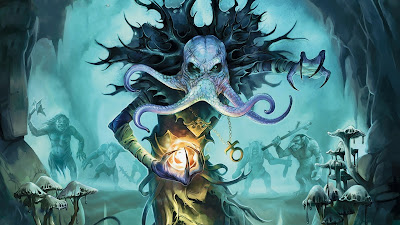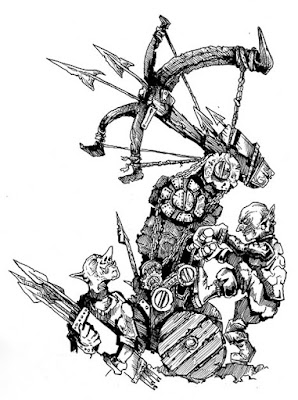 |
| Stay over there, I want to cast a spell |
Artillery
This one seems pretty straightforward, but we'll be doing some fun math this week to lay the groundwork for some more complex monster roles in the coming weeks.Artillery have the following traits:
- Powerful Ranged attacks
- High attack bonus on Ranged attacks
- Defense against Ranged attacks
- Low AC in Melee
- Low HP
- Average mobility
 |
| Eight times the artillery, Eight times the fun! |
The first and easiest way to turn a monster into artillery is to give it a ranged attack equal in power to its melee attack. Kobolds, our normal test subjects, already have this feature with their sling attack. So let's look at another monster that we could turn into artillery.
Bugbears are potent melee combatants, but deal pitiful damage at range, especially for a CR 1 creature. What if we had one Bugbear hanging back, firing past his allies? We'd want it to deal at least 11 damage, to make up for the fact that the bugbear wasn't in melee. Beating that brute ability is tricky to do with the weapons in the PHB.
However, on the DMG pg 255 we find our solution. This Bugbear is firing a hobgoblin-made ballista! Perfect for keeping him in the back - it could be stationary. And instead of 3d10 damage, we could say it's a medium-sized ballista and only deals 2d10 damage - an average of 11, the same as a melee bugbear's Morningstar attack. To finish it off, we can have a couple of unarmed goblins assisting with the loading and aiming of the ballista.
But what if we wanted the full shebang - a large ballista dealing 16 damage a round? Well, that would increase his CR. Remember our equations:
- Damage Increase/decrease per Round / 12 = Increase/decrease in CR
- Effective HP increase/decrease / 30 = Increase/decrease in CR
 |
| Somehow seems like a bad idea... |
The normal bugbear has 27 (5d8 + 5) HP. We want it lowered to at most, 12. Well, just like a PC, the HP of a monster is (their average hit die + their Con modifier) x their "level". For monsters, "level" isn't connected to CR, it's just how many hit dice the monster has. So all we have to do is lower the bugbear's number of hit die.
A d8 averages out to 4.5 (due to the probability of the die rolls). So each of the bugbear's hit dice add 5.5 HP to its total. That means all we have to do is lower this bugbear's HP down to 11 (2d8 + 2) and we're back at a CR 1 creature. It makes sense, as well, that the scrawniest Bugbear would hang back and fire the ballista.
Basically, we made the Bugbear more dangerous in combat, but easier to kill, meaning we can reasonably expect him to deal about the same amount of damage as a normal Bugbear. As long as he stays in the back where he belongs.
Remember that this process can be applied to any monster, and can adjust AC as well. As long as the defensive stats are adjusted to compensate for the higher offensive capabilities. Or you're okay with throwing tougher monsters at your players.
 |
| Two words: Vampire. Army. |
How do we calculate for magic in CR? It's obviously dependent on the spells a monster casts. There are offensive and defensive spells, and they can both affect CR.
The first step you can take to figure out the effect of magic on CR is to compare the effect of the spell to the list of Monster Features on DMG pg 280. Let's take an offensive and defensive spell: Fireball and Shield.
We have two analogues for Fireball: Breath Weapons and Death Bursts. It looks like both assume that it will affect two targets, and each target will fail its saving throw. That's a fair assumption, since we might hit more targets but some will make their saves.
Both Breath Weapons and Death Bursts assume that we use that ability "for 1 round". That's because when it comes to calculating single-shot effects, we assume the creature can only use it once (on average) every three rounds. That also tells you a lot about how long the designers of D&D estimated a combat would last.
 |
| It's funny that they though soldiers would be enough |
The average Fireball deals 28 damage. Assuming it hits two targets and they fail their save, just giving a creature 3 Fireballs increases its CR by 2!
Now let's look at Shield. It uses a reaction to increase the creature's AC by 5. At first, this might seem to be similar to Parry from the Monster Features table. But there's a caveat: Shield lasts an entire round, and Parry is against a single attack.
Again, it comes down to how many times a wizard is able to cast the spell. Assuming the wizard has at least three 1st-level spell slots, there's no reason why you wouldn't add the full amount to their effective AC.
Using the AC equations from last week:
- If CR is above 1, AC increase/decrease / 4 = Increase/decrease in CR
- If CR is less than 1, AC increase/decrease /8 = Increase/decrease in CR
 |
| It's a great spell, but it's mostly used to deflect the Barbarian's halitosis |
I'm not going to get into that here, because if you muck around with a creature's statistics too much you can destroy some of the basic traits that make it the type of monster it is. I promise, your players will not enjoy fighting a clay golem with 9 strength and 20 dexterity. First because suddenly the wizard's Fireball is nerfed, and second because it's unlike any other Golem in the game. You'd be breaking your immersion.
Now, as a last point, let's discuss how to give defense against ranged attacks.
The easiest way to do this is to give the monster proficiency on dexterity saving throws. This will provide better cover against the best ranged attacks - magic. You can also put the monster behind cover, which grants it extra AC and a bonus on Dex saves - without increasing its CR!
Another idea would be giving the creature the monk's "Deflect Missiles" ability (PHB pg. 78). I would count this as a type of Parry-like ability that would add to the monster's effective AC, increasing it by 1 or 2 depending on how much damage reduction you allow.
I think that about wraps it up for Artillery. Want to give a Kobold magic abilities and see where it gets us? I do!
 |
| SURPRISE |
Thanks for reading!

No comments:
Post a Comment